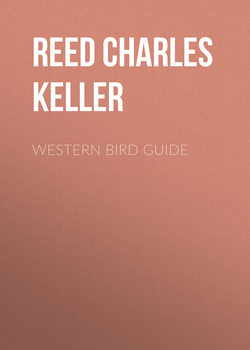Читать книгу Western Bird Guide - Reed Charles Keller - Страница 6
FULMARS AND SHEARWATERS
Family Procellariidæ
ОглавлениеPACIFIC FULMAR
86b. Fulmarus glacialis glupischa. 18 inches
In markings these birds closely resemble the Gulls. Bill is shorter and stouter, strongly hooked at the tip, and with the nostrils opening out of a single tube, prominently located on top of the bill. Their flight is graceful like that of the Gulls.
Nest.– On the islands and cliffs of the mainland of the Northern Pacific they nest in large colonies. Every crevice in the rocks having its tenant. They lay but a single white egg on the bare rocks (2.90 × 2.00).
Range.– Northern Pacific, southerly to Lower California.
SLENDER-BILLED FULMAR
87. Priocella glacialoides. 18 inches
This species has a paler mantle than others of the family, and the primaries are black.
Range.– Southern seas, appearing on the Pacific coast of the United States in the summer. They probably breed in the far south during our winter, although we have no definite record relative to their nesting habits.
PINK-FOOTED SHEARWATER
91. Puffinus creatopus. 19 inches
Very little is known of the breeding habits of this bird. Upper parts and under-tail coverts are a pale brownish color, darkest on the wings; top of head dark, with throat and breast white, with yellowish bill and pink colored feet.
Range.– From Monterey, California, to South America.
BLACK-VENTED SHEARWATER
93. Puffinus opisthomelas. 14 inches
Similar to the previous, only smaller and somewhat lighter in color. Quite common in southern California and much more so in Lower California.
Range.– From northern United States to Lower California. A single white egg is laid (2.00 × 1.30).
TOWNSEND SHEARWATER
93.1. Puffinus auricularis. 14 inches
A more southern species; occurs occasionally on the lower California coast and islands.
DARK-BODIED SHEARWATER
95. Puffinus griseus. 17 inches
This is a southern species which, after nesting on the islands in the far south during our winter months, comes north and appears off the Pacific coast of the United States during our summer months, as far north as Alaska. They are a dark sooty gray, except for the under-coverts, which are whitish.
Nest.– Habits are the same as the others of the family. The single white egg is laid at the end of the burrows or in crevices under rocks (2.40 × 1.65).
SLENDER-BILLED SHEARWATER
96. Puffinus tenuirostris. 14 inches
This is much smaller than the preceding, otherwise resembling it in color and markings, being a little lighter under the throat, and the bill more slender in proportion to the size of the bird. Bill and feet nearly black, as is also the one above.
Nest.– Nesting habits and range of the bird are the same as the Dark-bodied Shearwater; it is not found on the N. A. coast as commonly as the other.
FISHER PETREL
100. Æstrelata fisheri. 7 inches
This is a handsome bird known only from the type specimen taken off Kadiak Island, Alaska, by Mr. Fisher.
LEAST PETREL
103. Halocyptena microsoma. 5½ inches
This is the smallest of the family. Their plumage is entirely dark sooty.
Nest.– They have been found breeding on the islands of Lower California, and they probably do on others farther south. The single egg of this bird is white with a wreath of tiny brown specks about the larger end.
FORK-TAILED PETREL
105. Oceanodroma furcata. 8 inches
These birds have a plumage of bluish gray, the wings being darker and the under parts lightest.
Nest.– Single egg is laid at the end of a burrow on the ground. Egg white with a fine wreath of purplish black specks about the larger end. Found breeding on the islands of Alaska.
KAEDING PETREL
105.2. Oceanodroma kaedingi. 7½ inches
This bird is similar to the following, but a trifle smaller and the tail less deeply forked. Its range is from northern California to Mexico, breeding in the southern part of its range.
LEACH PETREL
106. Oceanodroma leucorhoa. 8 inches
These are quite common on both the eastern and western coasts, breeding from the Farallones northward to the Aleutians. They are of a sooty brown color, upper tail-coverts and side of under-coverts white. They burrow in the ground for two or three feet, but make no attempt at nest building; placing their single white egg on the bare ground at end of burrow. These birds generally take turns in the task of incubation, one remaining at sea during the day and returning at night. They are rarely seen in the vicinity of their nests during the day.
GUADALUPE PETREL
106.1. Oceanodroma macrodactyla
Very similar to the preceding, having more of a forked tail and somewhat longer. Breed on the islands of Lower California.
Nest.– Same as above with one white egg, usually much nest stained.
BLACK PETREL
107. Oceanodroma melania. 7½ inches
These birds are sooty black all over, lacking the white rump of the two or three preceding. All of the Petrels have a very offensive musky odor, which is always noticeable about an island inhabited by them. The skins and eggs of the birds always retain this odor.
Nest.– Made in burrows similar to the others, but sometimes containing a small amount of nesting material; grass and roots.
Range.– Southern California southward to Mexico.
ASHY PETREL
108. Oceanodroma homochroa. 7 inches
This species breeds most abundantly on the Farallone Islands, sooty gray in color, their plumage matching their surroundings so closely that, unless one is looking for them, they will easily be overlooked.
They sit very close when nesting, and will even allow themselves to be removed from the nest by hand, so tame are they. They build in burrows or in any crevice of the rocks, laying their single white egg on the ground or rock without much, if any, lining to the nest.
